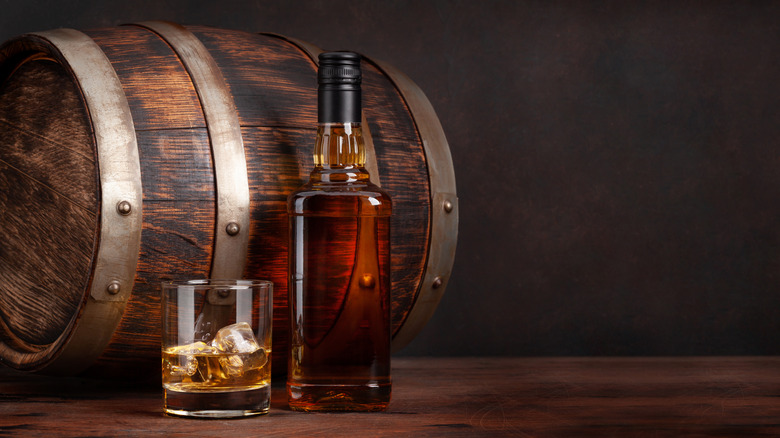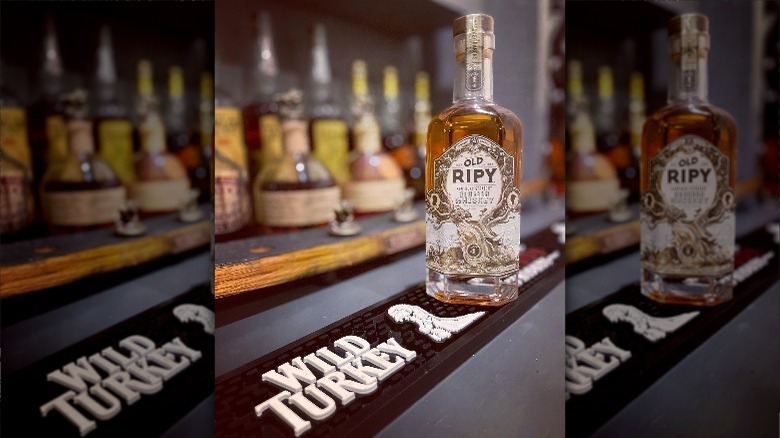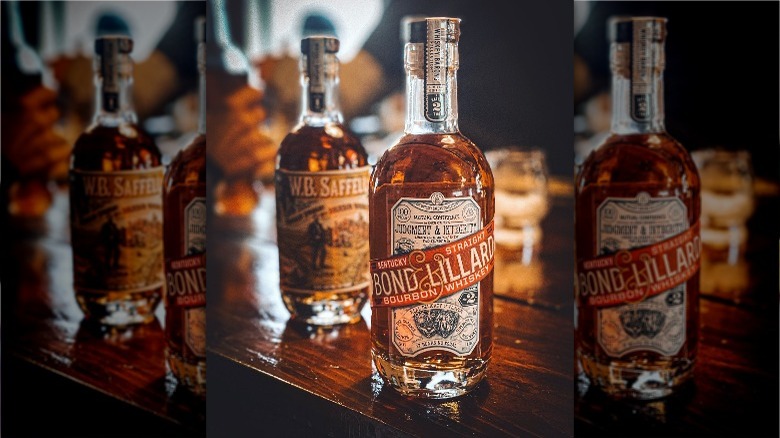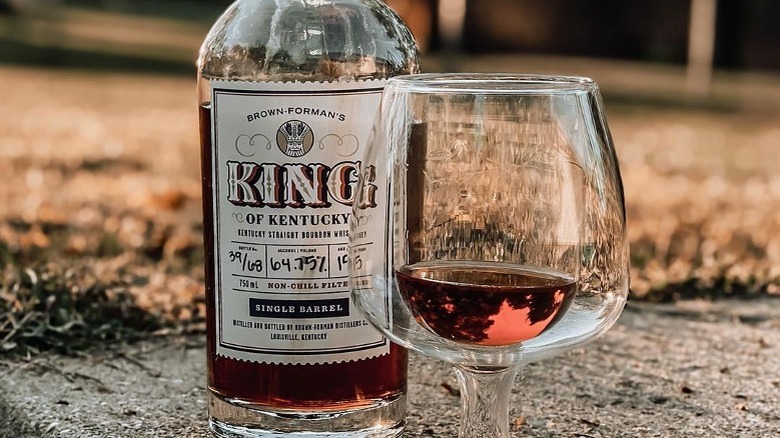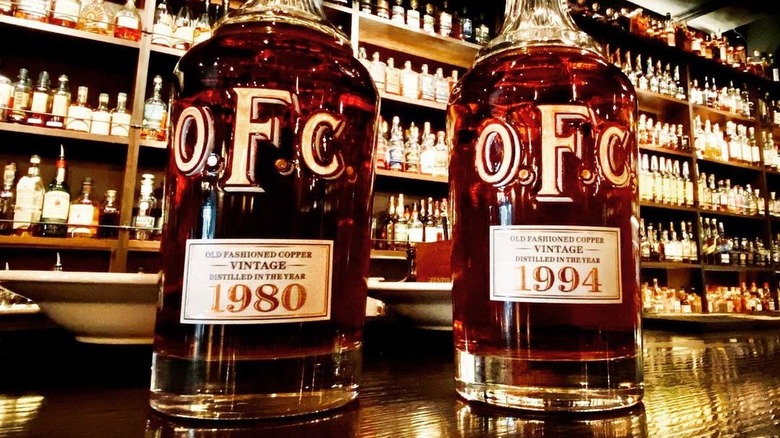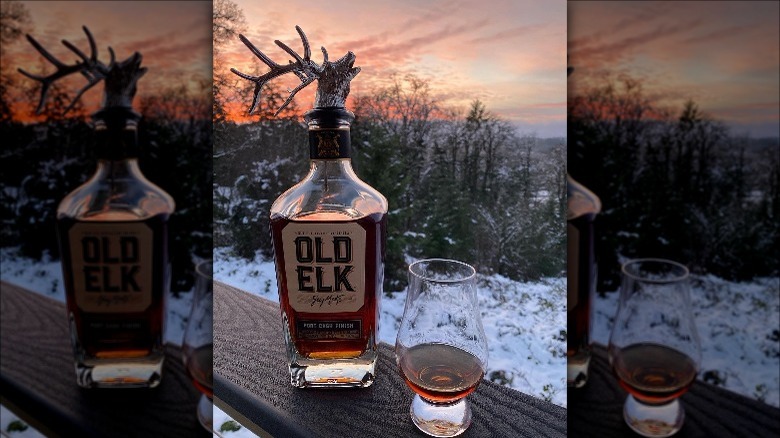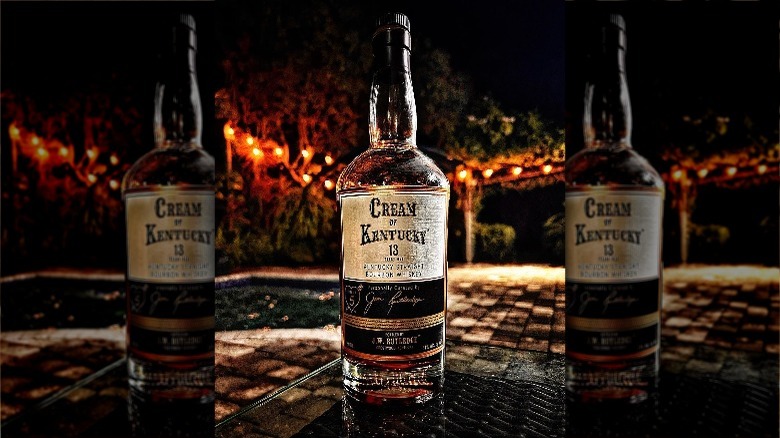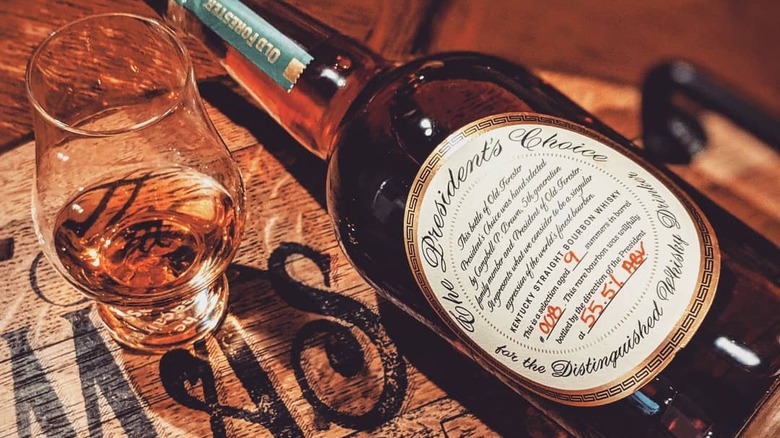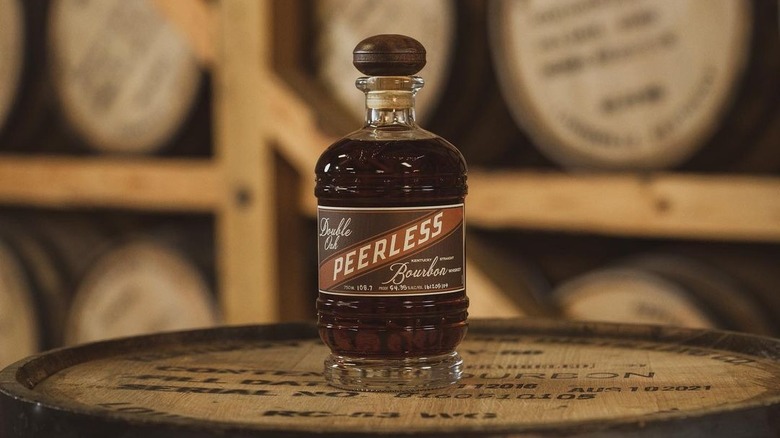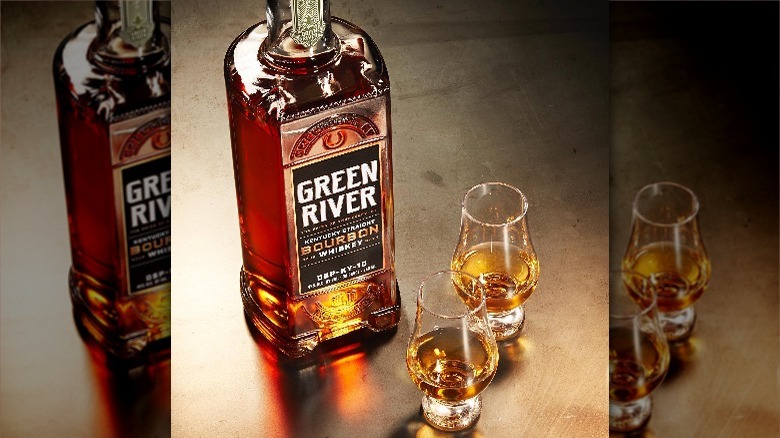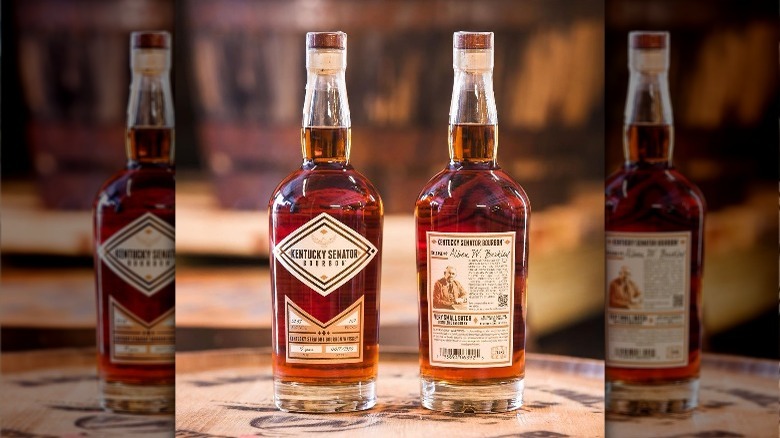11 Historic Bourbon Labels Revived By Modern Brands
In case you haven't noticed, bourbon is everywhere — from bars, restaurants, and tasting rooms, to dinner parties, home bars, and liquor store shelves, so long as they can keep it in stock. Some call it a "bourbon boom" or the "bourbon surge." However, terms like surge might suggest the increase in bourbon sales will eventually come back down. Although that is indeed possible, it's tough to predict, and as of now bourbon still remains wildly popular and in demand.
It may have been the cocktail revival and shows like "Mad Men" that brought bourbon and classic drinks like the old fashioned back to life, or the entrance of new small-batch and single-barrel bourbons from distilleries that piqued everyone's interest in bourbon whiskey, its history, and how it's made. However the boom occurred, one of the greatest benefits of our rekindled love for bourbon is how it's helped to revive old labels that were once forgotten. Bourbon has been in America since the land was settled in the 1700s. It's a deep-rooted history, and seeing old historic labels come to life again is nostalgic and exciting for collectors and newbies alike.
1. Old Ripy
James Ripy, an Irish immigrant, created Old Ripy bourbon shortly after the Civil War around 1868 and stopped production in 1950 when Prohibition and other issues caused them to have to cut back. As it so happens, the distillery that shut down is where the Wild Turkey distillery in Lawrenceburg, Kentucky, now sits. That's why when the Campari company, which owns Wild Turkey, decided to distill the revived Old Ripy, along with several more historic labels as a part of the Whiskey Barons collection at the Wild Turkey distillery. It's like it's come home again.
Old Ripy has a middle-of-the-road price point at around $50 for a 375-ml bottle. Some might buy it because of the gorgeous label which includes an old, rugged tree wrapped around the name of the bourbon, with colors and lettering that look like the bottle came right out of the 1800s. Buy it for the label, the history, the taste of oak, banana, caramel, and vanilla, or for your collection that is never opened. Either way, you'll be happy to own a piece of history and a beautiful bourbon.
2. Bond & Lillard
Bond & Lillard began in 1869, came to during after Prohibition, and has been revived in the same way as Old Ripy, through Campari's Whiskey Barons collection at the Wild Turkey distillery in Lawrenceburg, Kentucky. It's said that after Bond & Lillard won the Grand Prize as an outstanding bourbon at the World's Fair in St. Louis in 1904, Campari got a hold of the tasting notes and started their own bourbon journey with the inspiration in hand. Thankfully, they did, and now Bond & Lillard is back on the shelves.
Legend has it that a great-grandmother in the family, Sadie Hanks, otherwise known as Mam-Momma, and a devout Southern Baptist, kept the bottles filled in the distillery before Bond & Lillard lost its well-known name. That's reason enough to be intrigued and grab a bottle in honor of the world's coolest teetotaling grandmother.
Bond & Lillard is distilled using charcoal filtration, which is fairly unique in the bourbon industry and is said to remove carbon dioxide for a smoother, less bitter bourbon. Bond & Lillard somehow still carries the taste of way back when, which include an array of notes from the bourbon tasting wheel, such as florals, fruits, oak, vanilla, herbs, spices, and caramel.
3. King of Kentucky
King of Kentucky began as a straight bourbon in 1881, distilled by Kentucky Distillers. It was lost when the company was acquired by Brown-Forman in 1936, and the formula was changed to create a blended bourbon around 1940. But by 1968, the King of Kentucky label had disappeared completely. Today, the Brown-Forman distillery has proudly brought the King of Kentucky back as a straight bourbon whiskey and a historical bottle, remembered for the time period it originated in as Kentucky became the "bourbon state."
Unfortunately, you won't easily find a bottle of King of Kentucky since the distillery only releases limited amounts at a time. The last release in 2022 was a 15-year and an 18-year with very limited supplies of about 3,500 bottles of the former and only 250 of the latter, and hefty price tags around $250 and $350, respectively. Still, it would be an impressive addition to any bourbon collection if you happen upon one.
4. O.F.C.
O.F.C. stands for Old Fire Copper and is full of history, beginning with the distillery that was established in 1869. Founder Colonel Edmund Haynes Taylor, Jr. began distilling and distributing whiskey differently than other Kentucky folks were doing it at the time. Colonel Taylor, who lived to be 90 years old, was one of the first to understand the importance of good marketing and paved the path toward merging excellent bourbon and advertisement.
George Stagg purchased the Old Fire Copper distillery back in 1878 and eventually named it the George T. Stagg distillery, which was already the facility that bottled O.F.C. bourbon for Old Fire Copper. The Stagg distillery was fortunate to be one of the few distilleries to receive permission from the government to produce whiskey for medicinal purposes during Prohibition. In 1992, the distillery was sold and renamed again, becoming Buffalo Trace. It only produced O.F.C. for a limited time for charitable causes or auctions. You can still bid for bottles today, if you're willing to pay a hefty price.
5. Old Elk
Old Elk is an old label, recently revived by an up-and-coming distiller in Colorado, Old Elk Distillery. Originally created by the Stoll, Clay, & Co. Distillery near Lexington, Kentucky, in 1880, the whiskey was and is now a blended straight bourbon. After going through some changes as many distilleries do through the years, eventually, Stoll, Clay, & Co. became Edge Cliff Distillery. During Prohibition, it acquired by Stitzel Distillery and was bottled for medicinal purposes. Old Elk was sold again in 1972 and after that it was left to fade away. It only came back to life recently when the new Old Elk Distillery revived the label.
As a blended straight bourbon, Old Elk is unique in its proprietary "Slow Cut" proofing process, which entails adding fresh mountain water at several intervals over many weeks at a time, with the goal of preserving the flavor of the bourbon while also mellowing the barrel proof whiskey. The result of Old Elk's patient proofing process is one of the smoothest bourbons you'll find.
6. Cream of Kentucky
Cream of Kentucky struck it big in the 1940s when Norman Rockwell was chosen to do the artwork for the company's ads. At that time the Schenley Corporation owned Cream of Kentucky, although it began with a different Cincinnati-based company in 1888. Thanks to Rockwell's classic Americana artwork and clever advertising, Cream of Kentucky skyrocketed in popularity and sales when Collier and Life Magazine's placed the full-page ads in their magazines, along with Norman Rockwell's signature. The ad read, "No finer whiskey is made than the 'Double-Rich' Cream of Kentucky...the largest-selling straight Bourbon whiskey in the world because its rich quality and rare flavor-character give more pleasure to more people. Win or lose. It's the perfect end for a day of golf or any other day!"
Today, Cream of Kentucky is alive and well again after taking a hiatus as many bourbons did when it wasn't the spirit of the times. The revival is due to master distiller Jim Rutledge, and his vision to bring back to life the premium bourbon with a creamy feel as it rolls across the tongue. Currently, J.W. Rutledge Distillery is in the process of building a modern, sustainable distillery. However, for now, J.W. Rutledge distills and bottles Cream of Kentucky at the Kentucky Artisan Distillery in Crestwood, Kentucky.
7. The President's Choice
Old Forester's The President's Choice is an old tradition that faded away when the barrels had nothing left to give. The label began with the Brown-Forman company in the 1940s, when George Garvin Brown II wanted to do something for his employees to show his appreciation. He reportedly decided to bottle up hand-selected barrels of bourbon and labeled them with a label reading "The President's Choice." He cleverly left a blank spot on the label so he could write the name of each employee on their own bottle, giving them a memorable keepsake and making each bottle one of a kind. In 1968, The President's Choice bottles became available for the public to purchase. However, by 1972, three years after Brown's death, the chosen barrels ran out and so did The President's Choice.
In 2018, Old Forester opened their new distillery in downtown Louisville and wanted to celebrate by offering an impressive bottle of bourbon. And just like that, The President's Choice was resurrected. Now, each bottle carries Old Forester President Campbell Brown's name, only after he has tasted the barrel and approved.
8. Kentucky Peerless
After 102 years, Kentucky Peerless was brought back to life in 2019. Like so very many bourbon labels, Kentucky Peerless was successful early on. It was producing about 10,000 barrels a year by 1913 and then 23,000 by 1917, until the ultimate block of distilling emerged — Prohibition. Production ceased and so did Kentucky Peerless bourbon.
In 2014, Corky Taylor, the great-grandson of Henry Kraver who began Kentucky Peerless in 1889, and his son Carson Taylor began the renovations of a historical building in downtown Louisville, which is now the beautiful new distillery for Kentucky Peerless. In March of 2015, the Taylor family rejoiced as they filled the first barrel with Peerless bourbon since 1917. By November 2017, Kentucky Peerless was named as one of the best bourbons in the world by Whiskey Advocate. Fred Minnick writes, "Delivering a buttery mouthfeel with toasted rye and baking spice notes, Peerless is the only craft producer on our list ... Peerless is paving the way and we expect more craft distillers to join them."
9. Green River
Green River, located in Owensboro, has deep roots in Kentucky as the 10th oldest distillery in the Bluegrass state. After its founding in 1885 by John W. McCulloch, Green River Distilling Co. left the scene when Prohibition entered it. Green River was well known back in the day as "The Whiskey Without Regrets," a tagline that made them famous as they collected awards at the Paris Exhibition in 1900 and the Liege Exhibition in Belgium in 1905.
After 100 years of rest, Jacob Call, a master distiller with a long lineage of distillers before him, brought Green River Bourbon back to life in the same distillery where it was born. Call's family history in bourbon dates back to the 1700s when Samuel Call distilled bourbon on his own farmland. Shortly after Call resurrected the bourbon Green River was acquired by Bardstown Bourbon Company, and today the legacy lives on along the Bourbon Trail in Kentucky.
With its rich history, Green River is one of the best bourbons you'll find for the price, as it is usually about $35 a bottle. With some historic labels well into the hundreds, this one might be worth picking up.
10. Pike's Magnolia
The vintage design of Pike's Magnolia bourbon label makes the bottle look like it came right off the shelf in an old western, and co-founder Ed Carey wouldn't have it any other way. Though Pike's Magnolia bourbon began in Cincinnati in 1849, it didn't last long due to — you guessed it — Prohibition. Up until then, it was quite popular and the original company, owned by Samuel Napthali Pike, enjoyed sales throughout the United States and Europe.
Rather than develop his own bourbon, Pike sourced bourbon from multiple distilleries, combining them until he came up with the perfect blend he could bottle and sell. When Carey discovered the old label, he decided to stay true to its beginnings and now bottles Pike's Magnolia in the same way. Carey tells 614 Now, "Our spirits are coming from a distillery in Lawrenceburg, Indiana, our bottles are coming from Pennsylvania, and labels are from Virginia." Pike's Magnolia is now sold in some U.S. states as well as Alberta, Canada.
11. Kentucky Senator
After originating with Crigler & Crigler of Covington, Kentucky, Senator Bourbon was eventually bought by Double Springs Distilleries of Bardstown, Kentucky. The label faded away and today it's been revived by Kentucky Senator Spirits, LLC. The bourbon makes itself unique by naming releases after Kentucky senators. The first release after its comeback was a 15-year, small-batch bourbon, whose namesake is Senator Alben W. Barkley of McCracken County. As Kentucky Senator Spirits say, its bourbon is a blend of history and commitment.
The brand has too many awards to mention, but they include the prestigious American Spirits Council of Tasters gold award in recognition of its first small-batch bourbon, including the taste and overall craft, and then another ASCOT gold award for marketing. Kentucky Senator Bourbon also made Fred Minnick's top 100 list in 2022 for best American whiskeys, where bottles are judged by taste, aroma, and finish using a scale of 100 to score.
